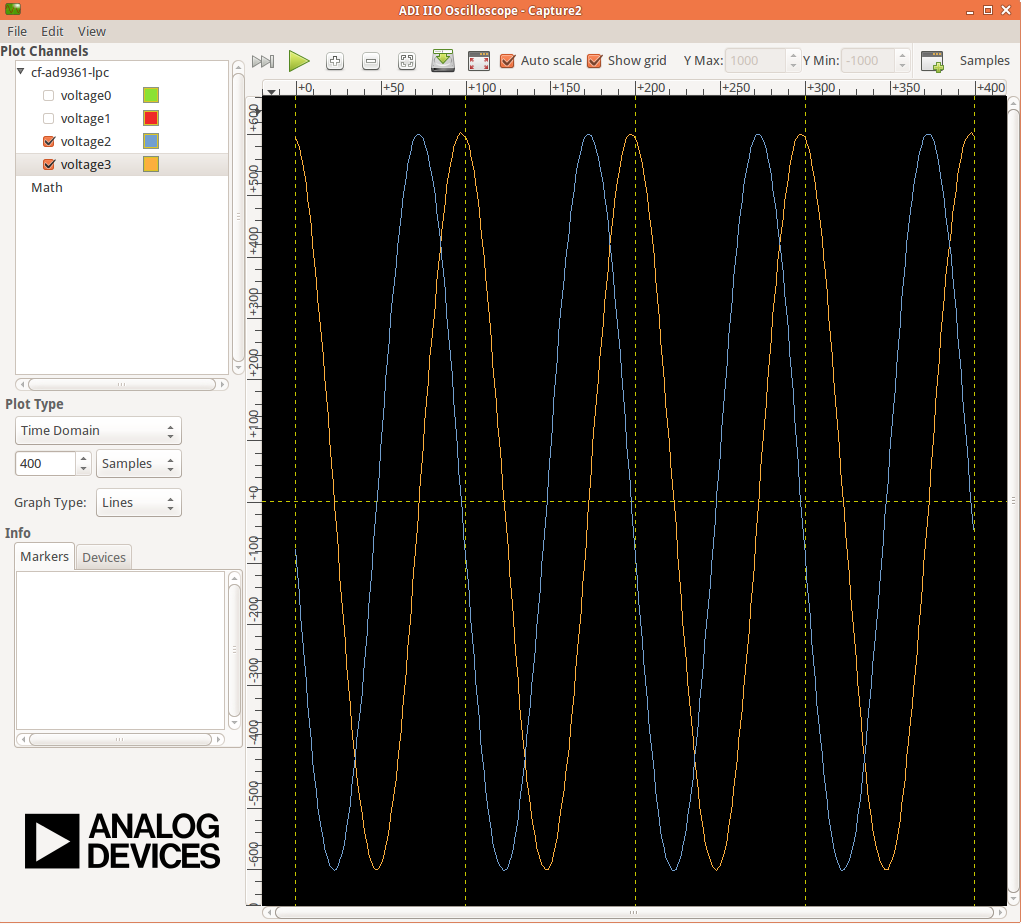 This version (10 Feb 2020 14:54) is a draft.
This version (10 Feb 2020 14:54) is a draft.
This is an old revision of the document!
This wiki page describes how to add a custom processing module into the FMCOMMS2's TX and/or RX data path. In this example, the custom modules are going to be some digital FIR filters, to decimate and interpolate the incoming and outcoming data stream.
Let’s presume we want to transmit a sinewave with the AD9361 ADI Integrated RF transceiver, the sinewave frequency is below 6 MHz, for this, we can use a lower system data rate than the reference design. But, by simply lowering the data rate of the system we will increase the equalization error. To avoid this issue we can add some interpolation filters for transmitting. A similar problem is encountered on the ADC side when receiving a low-frequency signal. This can be solved with the use of decimation filters. In our example, these filters were already implemented in “util_fir_int” and “util_fir_dect” HDL IP core, which are wrappers for the FIR Compiler Xilinx IP. The wrappers are used to manage the data rates entering the filter and to facilitate the configuration of the filter parameters for a specific application (Tx/Rx).
The interpolation/decimation filters parameters and coefficients were calculated in MatLab.
Interpolation FIR filter:
ast = 80; n = 128; tw = 0.1; interp = 8; f = fdesign.interpolator(interp,'Nyquist', interp,'N,Ast', n, ast); hf = design(f,'kaiserwin'); hq = dfilt.dffir(hf.Numerator./interp);set(hq, 'Arithmetic', 'fixed'); coewrite(hq, 10, 'coefile_int_8'); fvtool(hq);
Decimation FIR filter:
ast = 80; n = 128; tw = 0.01; decim = 8; f = fdesign.decimator(decim, 'Nyquist', decim,'N, Ast', n, ast); hf = design(f); hq = dfilt.dffir(hf.Numerator); set(hq, 'Arithmetic', 'fixed', 'CoeffWordLength', 18); coewrite(hq, 10, 'coefile_dec'); fvtool(hf);
After running the above commands in MatLab you will obtain some “*.coe” files, that will be processed by the Xilinx FIR Compiler IP.
In the original fmcomms2 design the data comes from the DMA, goes to the util_upack core which transmits the individual channel data to a dac_fifo core, from which the ad9361 core reads the data and transmits it to the AD9361 CHIP. The util_upack core is used to split the 64-bit data containing 2 RF channels, each one having I/Q data. dac_fifo is used for clock domain crossing between the system clock and the AD9361 clock.
The data processing is done at lower clock frequencies. This is the reason for placing the interpolation filters in front of the dac_fifo module. The required input data for the filter is I/Q data and the output is independent I and Q data. Because of this conditions, we still require the util_upack module, but we only need to split the DAC data into independent channel data, so we need one unpack module and two util_fir_int modules before the FIFO. The same approach is implemented on the receive path. For more information about the reference design visit:
The modified reference design block diagram containing now Interpolation and Decimation filters is presented below.
The design is obtain by simply sourcing the base fmcomms2 block design.
set project_dir [pwd] cd $ad_hdl_dir/projects/fmcomms2/zc706/ source system_bd.tcl cd $project_dir
At this point fmcomms2 reference design's TX data path has the following components:
We need to remove the connections between util_upack and dac_fifo cores in order to add the FIR filter modules in the reference design. With the following commands, all the unwanted connections will be removed and new ones will be created.
# delete reference design connections delete_bd_objs [get_bd_nets -of_objects \ [find_bd_objs -relation connected_to [get_bd_pins util_ad9361_dac_upack/dac_valid_*]]] delete_bd_objs [get_bd_nets -of_objects \ [find_bd_objs -relation connected_to [get_bd_pins util_ad9361_dac_upack/dac_enable_*]]] delete_bd_objs [get_bd_nets -of_objects \ [find_bd_objs -relation connected_to [get_bd_pins util_ad9361_dac_upack/dac_data_*]]]
We will disconnect/connect the Rx path in a similar manner.
delete_bd_objs [get_bd_nets -of_objects \ [find_bd_objs -relation connected_to [get_bd_pins util_ad9361_adc_pack/adc_valid_*]]] delete_bd_objs [get_bd_nets -of_objects \ [find_bd_objs -relation connected_to [get_bd_pins util_ad9361_adc_pack/adc_enable_*]]] delete_bd_objs [get_bd_nets -of_objects \ [find_bd_objs -relation connected_to [get_bd_pins util_ad9361_adc_pack/adc_data_*]]]
Adding interpolation filters
set fir_interpolator_0 [ create_bd_cell -type ip -vlnv analog.com:user:util_fir_int:1.0 fir_interpolator_0 ] set fir_interpolator_1 [ create_bd_cell -type ip -vlnv analog.com:user:util_fir_int:1.0 fir_interpolator_1 ]
Adding interpolation control
set interp_slice [ create_bd_cell -type ip -vlnv xilinx.com:ip:xlslice:1.0 interp_slice ]
Adding decimation filters
set fir_decimator_0 [ create_bd_cell -type ip -vlnv analog.com:user:util_fir_dec:1.0 fir_decimator_0 ] set fir_decimator_1 [ create_bd_cell -type ip -vlnv analog.com:user:util_fir_dec:1.0 fir_decimator_1 ]
Adding decimation control
set decim_slice [ create_bd_cell -type ip -vlnv xilinx.com:ip:xlslice:1.0 decim_slice ]
The interpolation filter has a 32-bit (I+Q) input data bus. In the base design, the unpack module is configured to output 4 channels of 16-bit data. By changing the unpack number of channels to 2 and the width of the channels to 32-bit will not work because of how the independent I/Q channel data is arranged in the 64-bit data bus coming from the DMA see the figure below.

More information about the util_upack_core util_upack_core
As a fact the data transmuted/received trough LVDS interface at DDR (Double Data Rate) is presented in the diagram below.

At this point we have two options:
For this example, the upack_core was kept. The core's proprieties remain unchanged, and a concatenate module was added, in order to merge the data coming out from the unpack module, then feed it into the interpolation filter.
Adding concatenation modules.
set concat_0 [ create_bd_cell -type ip -vlnv xilinx.com:ip:xlconcat:2.1 concat_0 ] set_property -dict [list CONFIG.IN1_WIDTH.VALUE_SRC USER CONFIG.IN0_WIDTH.VALUE_SRC USER] $concat_0 set_property -dict [list CONFIG.IN0_WIDTH {16} CONFIG.IN1_WIDTH {16}] $concat_0 set concat_1 [ create_bd_cell -type ip -vlnv xilinx.com:ip:xlconcat:2.1 concat_1 ] set_property -dict [list CONFIG.IN1_WIDTH.VALUE_SRC USER CONFIG.IN0_WIDTH.VALUE_SRC USER] $concat_1 set_property -dict [list CONFIG.IN0_WIDTH {16} CONFIG.IN1_WIDTH {16}] $concat_1
The same principle is applied to the RX path for the pack_core. The difference is that we need to split the data outputted by the decimation filters to obtain the independent I/Q channel data.
set pack0_slice_0 [ create_bd_cell -type ip -vlnv xilinx.com:ip:xlslice:1.0 pack0_slice_0 ] set_property -dict [list CONFIG.DIN_FROM {15}] $pack0_slice_0 set_property -dict [list CONFIG.DIN_TO {0}] $pack0_slice_0 set_property -dict [list CONFIG.DOUT_WIDTH {16}] $pack0_slice_0 set pack0_slice_1 [ create_bd_cell -type ip -vlnv xilinx.com:ip:xlslice:1.0 pack0_slice_1 ] set_property -dict [list CONFIG.DIN_FROM {31}] $pack0_slice_1 set_property -dict [list CONFIG.DIN_TO {16}] $pack0_slice_1 set_property -dict [list CONFIG.DOUT_WIDTH {16}] $pack0_slice_1 set pack1_slice_0 [ create_bd_cell -type ip -vlnv xilinx.com:ip:xlslice:1.0 pack1_slice_0 ] set_property -dict [list CONFIG.DIN_FROM {15}] $pack1_slice_0 set_property -dict [list CONFIG.DIN_TO {0}] $pack1_slice_0 set_property -dict [list CONFIG.DOUT_WIDTH {16}] $pack1_slice_0 set pack1_slice_1 [ create_bd_cell -type ip -vlnv xilinx.com:ip:xlslice:1.0 pack1_slice_1 ] set_property -dict [list CONFIG.DIN_FROM {31}] $pack1_slice_1 set_property -dict [list CONFIG.DIN_TO {16}] $pack1_slice_1 set_property -dict [list CONFIG.DOUT_WIDTH {16}] $pack1_slice_1
Connecting the FIR interpolation filters on the Tx side.
# fir interpolator 0 ad_connect clkdiv/clk_out fir_interpolator_0/aclk ad_connect util_ad9361_dac_upack/dac_enable_0 dac_fifo/din_enable_0 ad_connect util_ad9361_dac_upack/dac_enable_1 dac_fifo/din_enable_1 ad_connect util_ad9361_dac_upack/dac_valid_0 fir_interpolator_0/s_axis_data_tready ad_connect util_ad9361_dac_upack/dac_valid_1 fir_interpolator_0/s_axis_data_tready ad_connect util_ad9361_dac_upack/upack_valid_0 fir_interpolator_0/s_axis_data_tvalid ad_connect dac_fifo/din_data_0 fir_interpolator_0/channel_0 ad_connect dac_fifo/din_data_1 fir_interpolator_0/channel_1 ad_connect dac_fifo/din_valid_0 fir_interpolator_0/dac_read ad_connect concat_0/In0 util_ad9361_dac_upack/dac_data_0 ad_connect concat_0/In1 util_ad9361_dac_upack/dac_data_1 ad_connect concat_0/dout fir_interpolator_0/s_axis_data_tdata # fir interpolator 1 ad_connect clkdiv/clk_out fir_interpolator_1/aclk ad_connect util_ad9361_dac_upack/dac_enable_2 dac_fifo/din_enable_2 ad_connect util_ad9361_dac_upack/dac_enable_3 dac_fifo/din_enable_3 ad_connect util_ad9361_dac_upack/dac_valid_2 fir_interpolator_1/s_axis_data_tready ad_connect util_ad9361_dac_upack/dac_valid_3 fir_interpolator_1/s_axis_data_tready ad_connect util_ad9361_dac_upack/upack_valid_2 fir_interpolator_1/s_axis_data_tvalid ad_connect dac_fifo/din_data_2 fir_interpolator_1/channel_0 ad_connect dac_fifo/din_data_3 fir_interpolator_1/channel_1 ad_connect dac_fifo/din_valid_2 fir_interpolator_1/dac_read ad_connect concat_1/In0 util_ad9361_dac_upack/dac_data_2 ad_connect concat_1/In1 util_ad9361_dac_upack/dac_data_3 ad_connect concat_1/dout fir_interpolator_1/s_axis_data_tdata # gpio controlled ad_connect axi_ad9361/up_dac_gpio_out interp_slice/Din ad_connect fir_interpolator_0/interpolate interp_slice/Dout ad_connect fir_interpolator_1/interpolate interp_slice/Dout
In this example, the TX data flow is controlled by the interpolation filter when interpolation is activated and by the axi_ad9361_core when interpolation is not active. In the reference design, the data flow is controlled by the ad9631_core.
We must connect the unpack core's dma_xfer_in port to VCC so that the unpack may transmit the valid and enable signals from one entity to another.
ad_connect util_ad9361_dac_upack/dma_xfer_in VCC
At this moment the Interpolation filters are completely integrated into the design and the data path should look like the one in the figure below.
Connecting the FIR decimation filters on the Rx side.
# fir decimator 0 ad_connect clkdiv/clk_out fir_decimator_0/aclk ad_connect util_ad9361_adc_fifo/dout_data_0 fir_decimator_0/channel_0 ad_connect util_ad9361_adc_fifo/dout_data_1 fir_decimator_0/channel_1 ad_connect util_ad9361_adc_fifo/dout_valid_0 fir_decimator_0/s_axis_data_tvalid ad_connect util_ad9361_adc_pack/adc_valid_0 fir_decimator_0/m_axis_data_tvalid ad_connect util_ad9361_adc_pack/adc_valid_1 fir_decimator_0/m_axis_data_tvalid ad_connect util_ad9361_adc_pack/adc_enable_0 util_ad9361_adc_fifo/dout_enable_0 ad_connect util_ad9361_adc_pack/adc_enable_1 util_ad9361_adc_fifo/dout_enable_1 ad_connect pack0_slice_0/Din fir_decimator_0/m_axis_data_tdata ad_connect pack0_slice_1/Din fir_decimator_0/m_axis_data_tdata ad_connect util_ad9361_adc_pack/adc_data_0 pack0_slice_0/Dout ad_connect util_ad9361_adc_pack/adc_data_1 pack0_slice_1/Dout # fir decimator 1 ad_connect clkdiv/clk_out fir_decimator_1/aclk ad_connect util_ad9361_adc_fifo/dout_data_2 fir_decimator_1/channel_0 ad_connect util_ad9361_adc_fifo/dout_data_3 fir_decimator_1/channel_1 ad_connect util_ad9361_adc_fifo/dout_valid_2 fir_decimator_1/s_axis_data_tvalid ad_connect util_ad9361_adc_pack/adc_valid_2 fir_decimator_1/m_axis_data_tvalid ad_connect util_ad9361_adc_pack/adc_valid_3 fir_decimator_1/m_axis_data_tvalid ad_connect util_ad9361_adc_pack/adc_enable_2 util_ad9361_adc_fifo/dout_enable_2 ad_connect util_ad9361_adc_pack/adc_enable_3 util_ad9361_adc_fifo/dout_enable_3 ad_connect pack1_slice_0/Din fir_decimator_1/m_axis_data_tdata ad_connect pack1_slice_1/Din fir_decimator_1/m_axis_data_tdata ad_connect util_ad9361_adc_pack/adc_data_2 pack1_slice_0/Dout ad_connect util_ad9361_adc_pack/adc_data_3 pack1_slice_1/Dout #gpio controlled ad_connect axi_ad9361/up_adc_gpio_out decim_slice/Din ad_connect fir_decimator_0/decimate decim_slice/Dout ad_connect fir_decimator_1/decimate decim_slice/Dout
Depending if you did your changes in GUI, you can click on “Generate Bitstream”. After the bitstream generation is complete. Click on Files > Export > Export Hardware, select include bitstream option.
If you did your changes directly in the Tcl files, you can use “make” to generate the bitstream and hdf file.
Now depending if your system is based on a zynq architecture, you will have to generate the BOOT.BIN. If you have a MicroBlaze soft processor in your system booting the Linux will is simpler.
More info on:
For simply testing the fmcomms2 with filter design we loop-back the data from TX to RX for each channel with a SMA to SMA cable.

When first booting up the design none of the filters will be active. For the beginning make sure you have the same LO frequency for RX and TX, as in the picture below. Configure the Transmit/DDS mode to DAC Buffer Output, and chose one of the .mat files there and press Load this will send data in the .mat file via DMA. This option was chosen because the DDS data does not pass through the FIR interpolation filters. On the decimation side, data will always pass through decimation filters.
Below you can see the setting for fmcomms2 and the data plot in FFT and Time Domain for the “sinewave_0.6.mat”. As a functionality example, only one of the 2 channels will be enabled.
FFT Domain
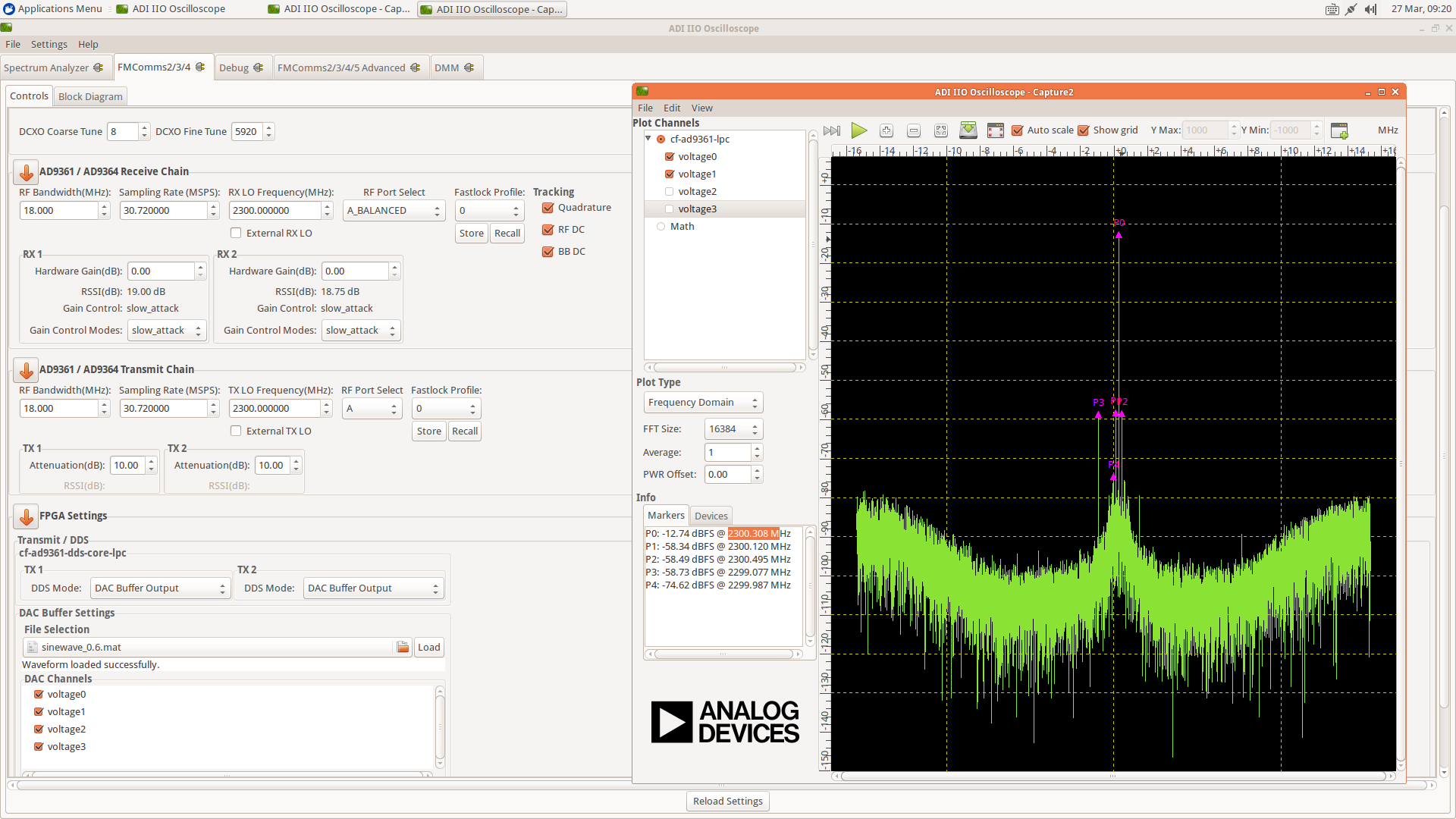 Time Domain
Time Domain
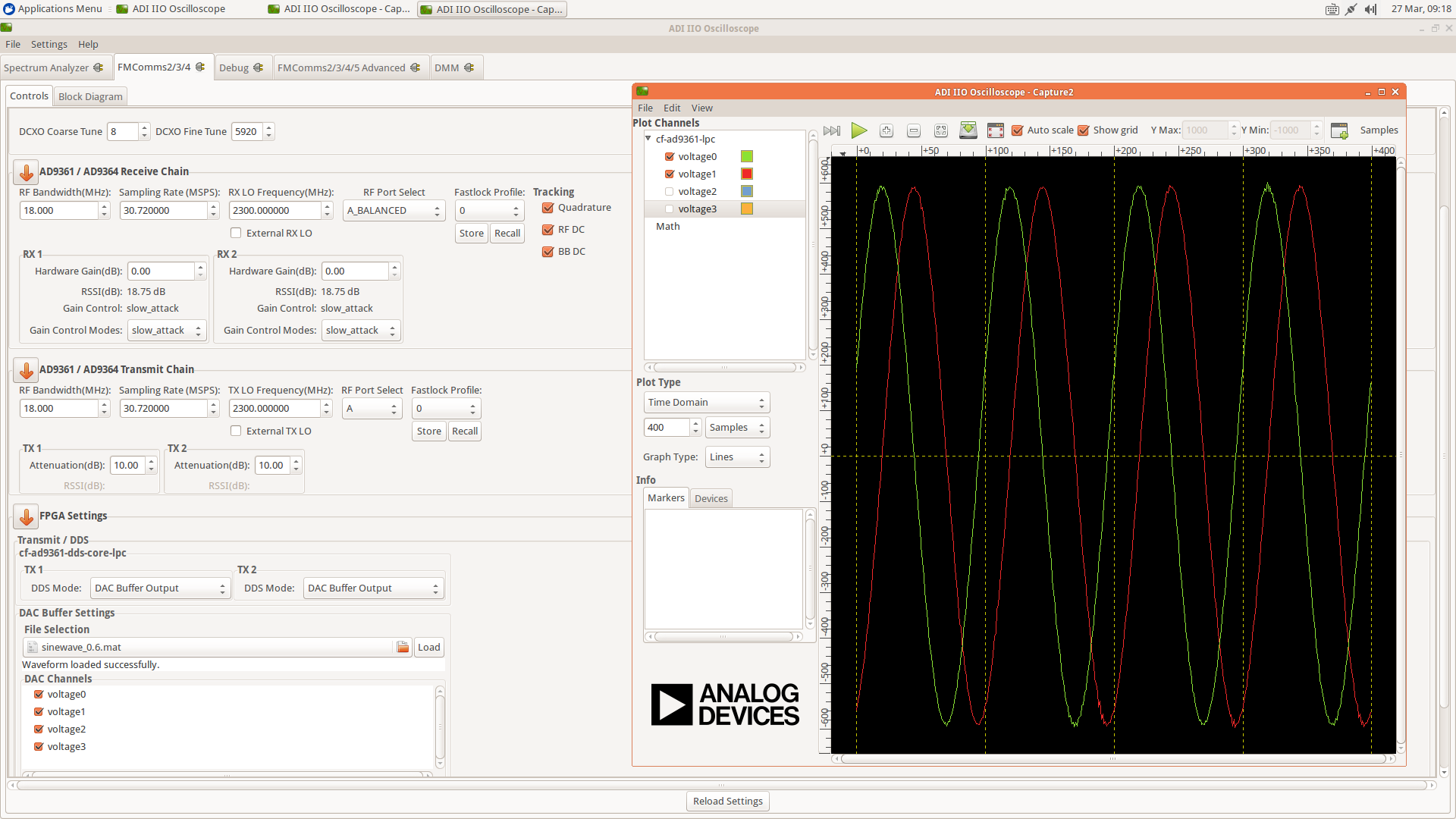
To better understand what is happening with the data inside the FPGA, 3 ILA (integrated logic analyzer) modules were added to the HDL design. The first ILA was connected to the control signals between the ad9361_core and the dac_fifo. Second ILA is monitoring the interpolation filters and the third ILA the decimation filters. As previously discussed above none of the filters are active and only one of the channels is enabled at this point.
ad9361_core control signals

Interpolation filters
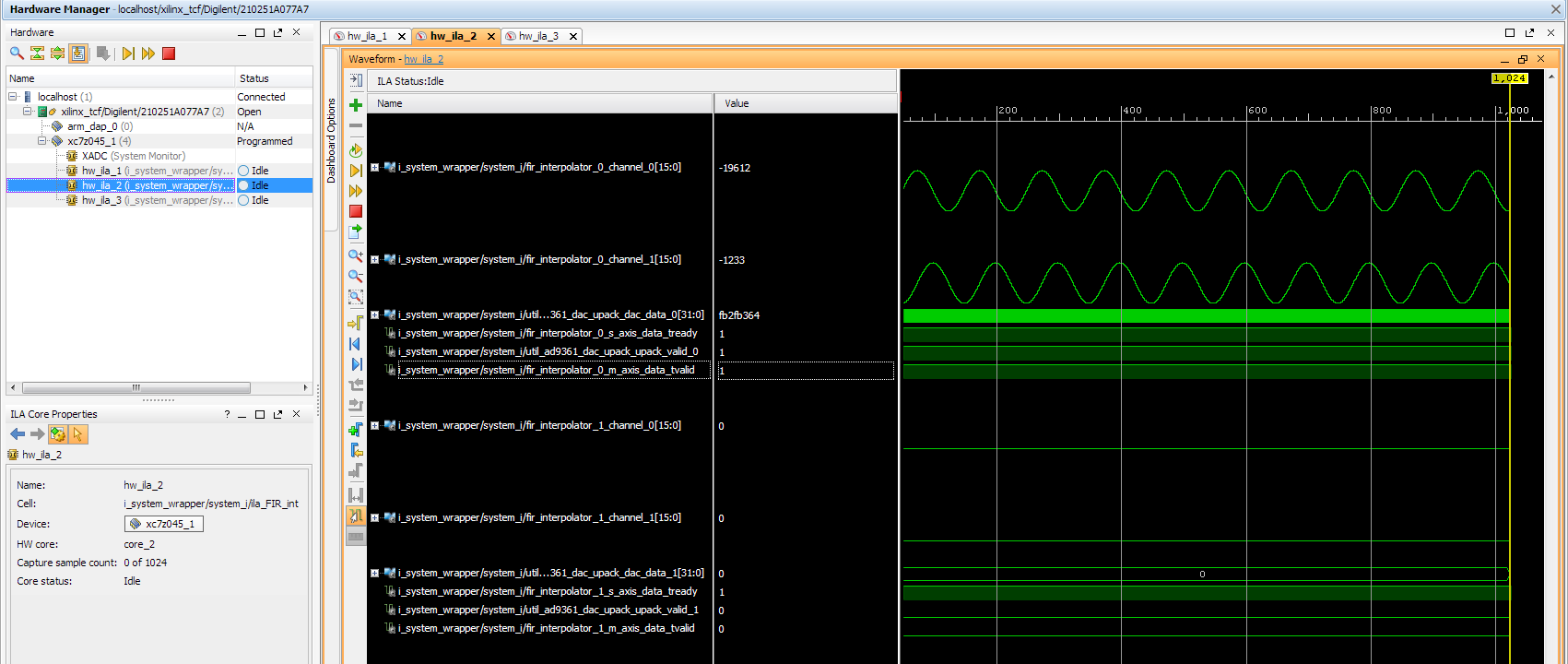
Decimation filters

In the Connecting the FIR interpolation filters on the Tx side section above, we added a GPIO control. The ad9361_core GPIO control register can be found in the register map at the address 0xBC axi_ad9361_core
To activate the interpolation filter one must go to the Debug mode. - At section Device selection chose “cf-ad9361-dds-core-lpc” - In the Register Map settings, select the source to be AXI_CORE - Read the 0xBC address then write 0x1 value at it, this will activate the filter.
Activating TX interpolation filters
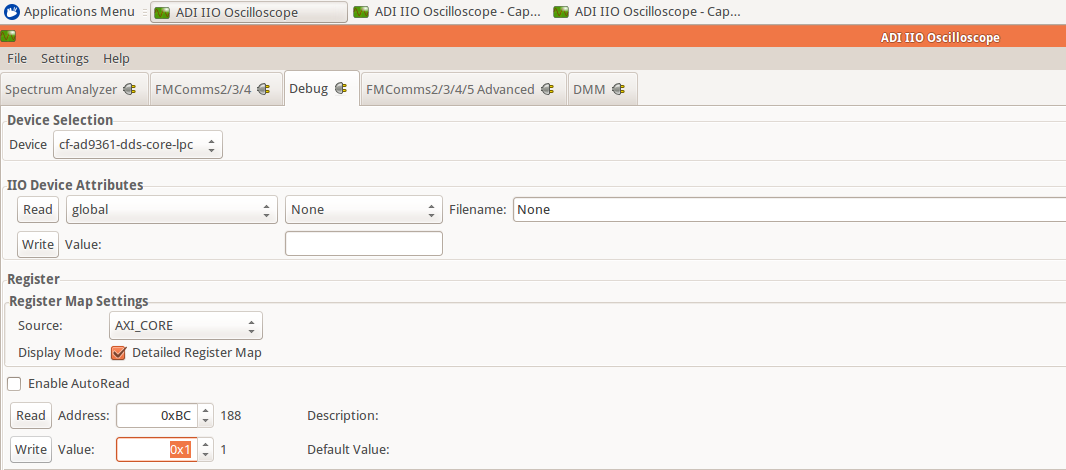
After activating the interpolation you can see in FFT domain a 1/8 smaller fundamental frequency than before (filter interpolation factor is 8)

The data captured by the ILA connected to the interpolation filters shows the smaller frequency sine wave and the 1/8 valid/clock signals.
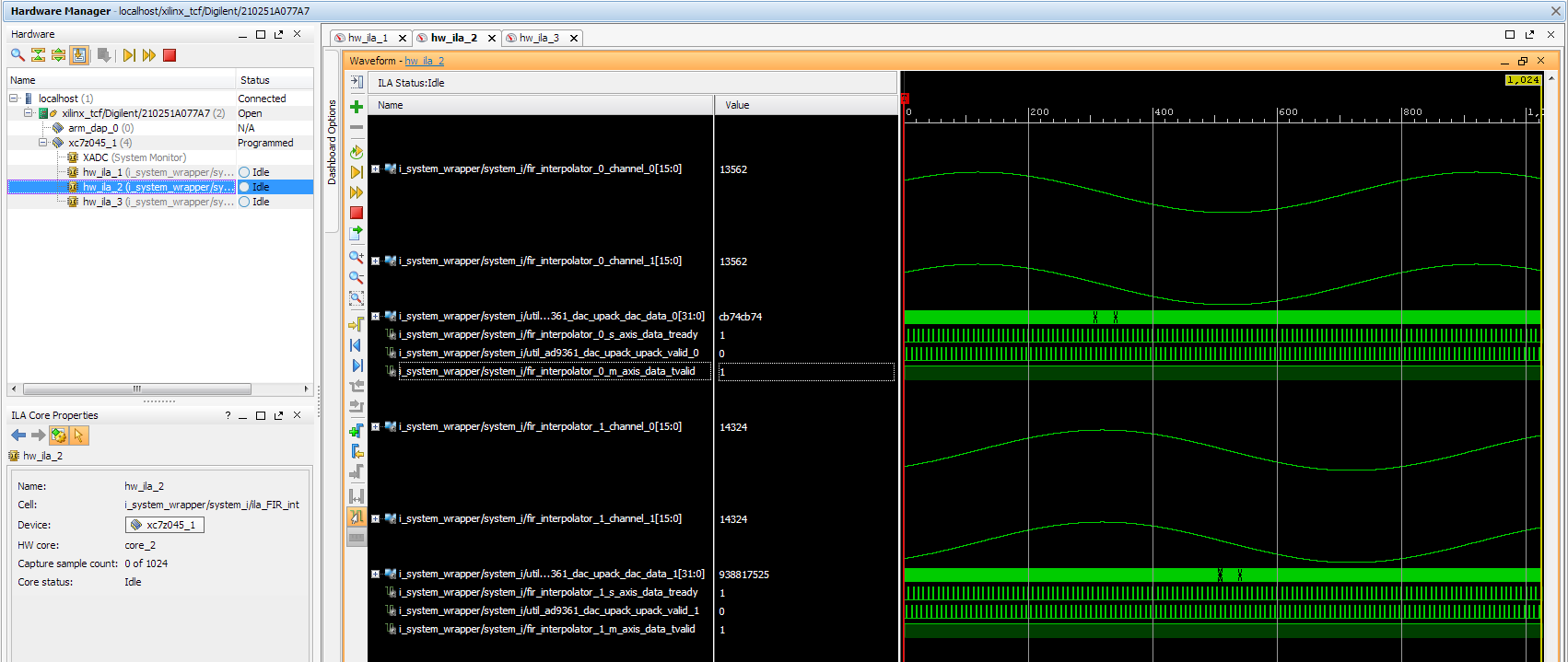
At this point again all filters are disabled.
Similar to interpolation, to activate the decimation we must go to the Debug, but this time select the “cf-ad9361-lpc”. Select the “Register Map Settings” source to be “AXI_CORE” and at the same address 0xBC (axi_ad9361_core) this time being the ADC side GPIO, write 0x1, as in the example below.
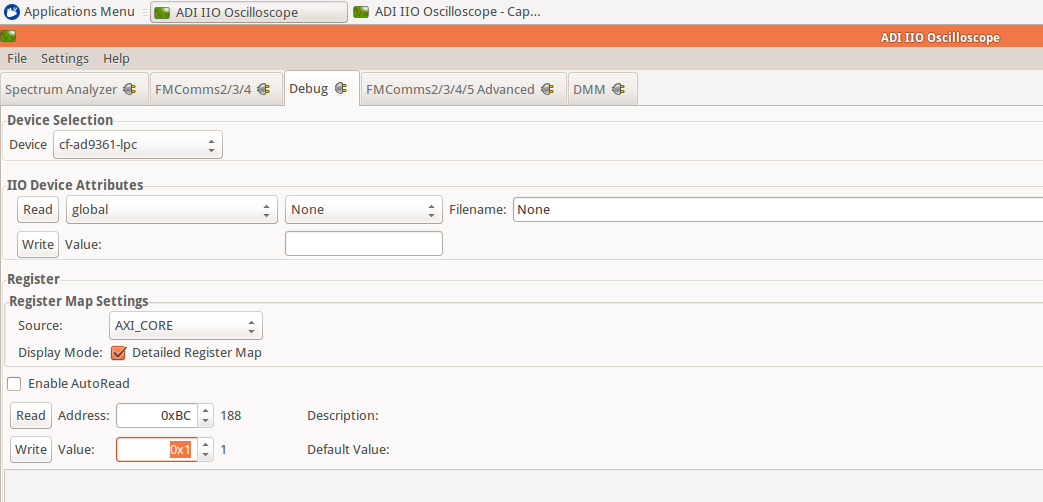
You will see in the FFT domain a frequency 8 times bigger than the one when the filters were inactive (decimation factor is 8).

The signals captured by the ILA:

FFT characteristic
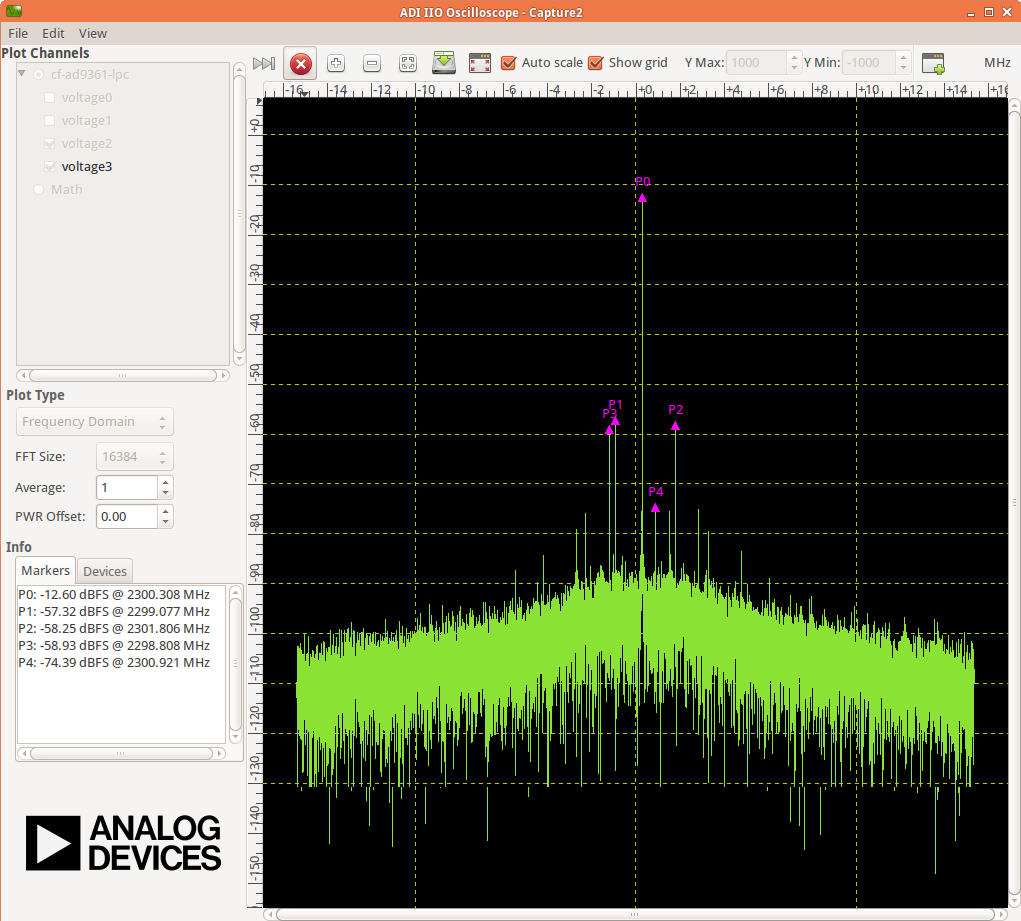
Time Domain characteristic
